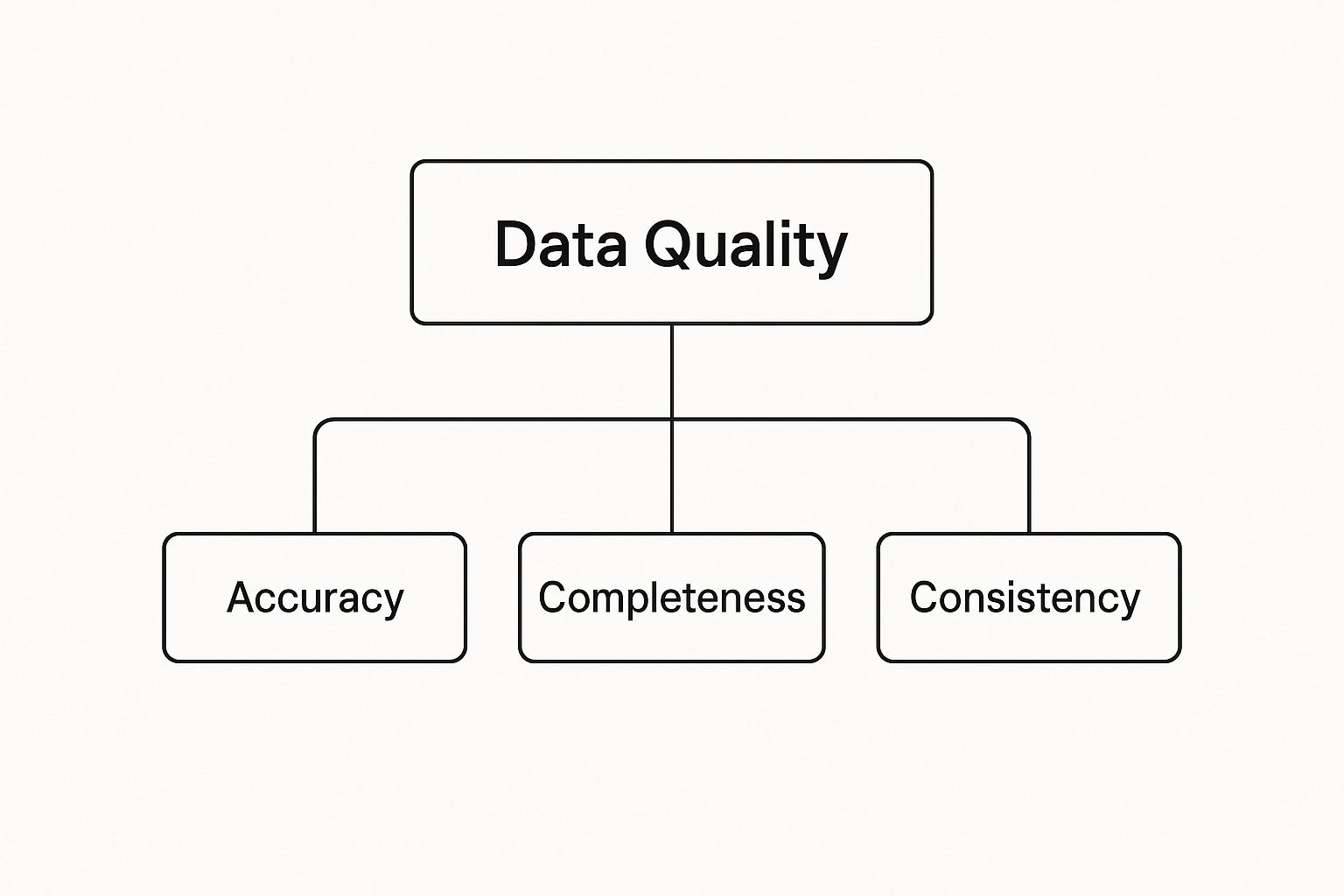Picture this: a clinician is about to make a critical call—a life-or-death decision—but they’re working with a flawed lab report or an incomplete patient history. That's not just a hypothetical scenario; it’s the stark reality of poor data quality in healthcare. This is a widespread, often invisible issue that directly impacts patient safety, operational efficiency, and the very future of medicine.
Why Data Quality Is Healthcare’s Hidden Crisis

The sheer volume of healthcare data is staggering. It's growing at an unbelievable clip, with some forecasts predicting a compound annual growth of 36% by 2025. This explosion of information, flowing from electronic health records (EHRs), medical imaging, and wearable devices, holds incredible promise. But all that potential vanishes if the underlying data is flawed.
Think of healthcare data as the foundation of a building. If that foundation is cracked, inconsistent, or just plain wrong, everything built on top of it becomes unstable. We're talking about everything from a single patient's diagnosis to a hospital's financial stability—it's all at risk of collapse. This isn't just an IT headache; it's a fundamental crisis that quietly erodes clinical decisions and patient trust.
The Scope of the Problem
This challenge is everywhere, and healthcare organizations know it. A recent industry report revealed a stunning statistic: 68% of healthcare organizations graded their own patient data quality as merely 'mixed' or 'poor'.
The problem gets even worse when data moves between providers. The same report found that 82% of organizations are worried about the quality of patient data they get from external sources. You can dig into the complete findings in the 2025 Healthcare Data Quality Report on morningstar.com.
This fundamental lack of trust in shared data creates massive roadblocks. It forces clinicians to waste precious time double-checking information or, worse, make crucial decisions with only a partial view of a patient's health.
When data can't be trusted, the consequences are severe and they ripple outwards. It's not about one-off mistakes but a systemic weakness that contributes to:
- Misdiagnoses and Treatment Errors: Incorrect data can easily lead to the wrong medication, a missed allergy, or a flawed diagnostic conclusion.
- Wasted Resources: Think of all the duplicate tests and procedures ordered simply because records are incomplete. This drives up costs for everyone.
- Stalled Innovation: The promise of AI in medicine hinges entirely on high-quality data. Inaccurate or incomplete datasets make powerful algorithms useless, or even dangerous.
This guide will demystify data quality in healthcare, breaking down what it really means, why it’s so critical, and—most importantly—how to start fixing it.
The Five Dimensions of Trustworthy Medical Data
When we talk about data quality in healthcare, it’s not as simple as labeling it "good" or "bad." It's far more nuanced. Think of it as a combination of five distinct, measurable traits. Each one is a pillar supporting the reliability of the information, and if even one is weak, the entire structure of a patient's record can become unstable.
This visual helps break down these core components.

As you can see, concepts like accuracy, completeness, and consistency aren't just buzzwords; they are the bedrock of trustworthy healthcare data. Building a reliable data ecosystem really boils down to getting each of these individual components right.
To really get a handle on this, let's look at each of the five dimensions in more detail.
The Five Key Dimensions of Healthcare Data Quality
The table below breaks down these five core pillars. It explains what each one means in a clinical setting and shows the real-world consequences when quality falls short.
| Dimension | What It Means | Example of Poor Quality | Impact on Patient Care |
|---|---|---|---|
| Accuracy | The data correctly reflects the real-world fact it's supposed to represent. | An EHR mistakenly lists a patient's allergy to penicillin as an allergy to sulfa drugs. | A life-threatening allergic reaction could occur if the wrong antibiotic is prescribed based on the incorrect record. |
| Completeness | All the required and necessary data is actually there. | A new patient's record is missing their family medical history and recent lab results from a previous provider. | The clinical team might order redundant, expensive tests or miss a crucial genetic predisposition to a disease. |
| Timeliness | The information is up-to-date and available when it’s needed. | A critical lab result showing a dangerous potassium level isn't entered into the EHR for 12 hours. | Treatment for hyperkalemia is dangerously delayed, putting the patient at risk for cardiac arrest. |
| Consistency | The same piece of data is uniform across different systems and records. | A patient's weight is recorded in pounds in the primary care EHR but in kilograms in the hospital's surgical system. | This could lead to a critical miscalculation of anesthesia or medication dosage, causing serious harm. |
| Uniqueness | Each patient has one single, comprehensive master record—no duplicates. | "John Smith" and "Jon Smith" (with the same DOB) have two separate records in the system. | His medical history becomes fragmented, leading to incomplete information for doctors and potentially conflicting treatment plans. |
As you can see, these dimensions are deeply interconnected. A single error—whether it's an inaccuracy or a delay—can cascade through the system, creating significant risks.
1. Accuracy
Accuracy is all about whether the data matches reality. Does the patient’s recorded blood type actually match the blood in their veins? Does the billing code reflect the procedure that was performed? Inaccurate data is so dangerous because it builds a false foundation, causing clinicians to make critical decisions based on information that is just plain wrong. A simple error, like an incorrect allergy note, can have devastating consequences.
2. Completeness
This one asks a straightforward question: is all the essential information present? A patient record with a missing medication history, a recent lab result, or even basic contact information has serious gaps. These blind spots force clinicians to fill in the blanks with educated guesses instead of making decisions with a full deck of information. It's a common reason for redundant tests and delayed care, as teams scramble to track down the missing pieces.
Think of it like a puzzle. If even a few pieces are missing, you can't see the full picture. In healthcare, that incomplete picture can directly impact a patient's diagnosis and care plan.
3. Timeliness
Data has an expiration date. Timeliness refers to how current the information is, because its value drops dramatically over time. A blood pressure reading from six months ago is practically useless for managing a patient with hypertension today; a reading from yesterday is invaluable. When there are delays in recording data—from lab results to a physician's notes—care teams are stuck looking in the rearview mirror, reacting to old news instead of addressing what's happening now.
4. Consistency
Consistency is the key to making sure data is synchronized and uniform everywhere it appears. A patient’s date of birth, for example, absolutely must be identical in the EHR, the lab information system, the billing platform, and the pharmacy portal. When it’s not—say, when a patient's weight is in pounds in one system and kilograms in another without proper unit conversion—it introduces confusion and erodes trust. This is one of the biggest culprits behind interoperability failures between different healthcare organizations.
5. Uniqueness
Finally, uniqueness is the principle that every patient should have one, and only one, master record. Duplicate records are a surprisingly common and serious headache, often created by something as simple as a typo in a last name ("Smyth" vs. "Smith") or a transposed number in a birthdate. These duplicates fracture a patient's medical history across multiple files, which can lead to fragmented care, conflicting treatments, and unnecessary medical procedures. The process of finding and merging these duplicates is fundamental to creating a single source of truth for each person's care journey.
How Bad Data Erodes Clinical Trust and Decisions

When the data a clinician relies on is unreliable, the whole system starts to wobble. This isn't just a matter of inconvenience; poor data quality in healthcare is a direct threat to patient safety and sound medical judgment. It creates a fog of doubt, forcing providers to second-guess the very information that should be guiding their most critical choices.
Think about an ER physician treating a new patient. The patient's record, just transferred from another hospital, is a mess. It's missing a recent medication change and lists conflicting allergies. This isn’t some rare, hypothetical scenario—it's a daily reality that chips away at trust and introduces enormous risk.
This forces clinicians into a tough spot. They have to spend precious minutes they often don't have trying to hunt down accurate information. Or worse, they might have to make a judgment call based on information they know is flawed or incomplete.
The Breakdown of Digital Faith
This constant unreliability has a corrosive effect. It shatters the faith that medical professionals have in the very digital systems built to support them. And this isn't a minor issue. A recent survey of data professionals revealed that 64% pinpointed data quality as the biggest obstacle to data integrity. The fallout is significant: 67% of those surveyed admitted they don't fully trust the data they use to make key decisions. You can read more about these findings on how data integrity challenges persist on precisely.com.
When data is questionable, every alert, every recommendation, and every digital record becomes suspect. This skepticism is the single biggest barrier to adopting powerful new technologies.
This erosion of trust has major implications for where medicine is headed.
- Hindrance to AI Adoption: Artificial intelligence and machine learning models are powerful, but they're also fragile. Their performance is completely dependent on the quality of the data they learn from.
- Amplification of Errors: An AI trained on bad data won't just fail; it can systematically repeat and even amplify existing errors, leading to flawed recommendations at a massive scale.
- Stalled Progress: Without a solid foundation of trustworthy data, the incredible promise of predictive analytics and automated diagnostics remains frustratingly out of reach.
Building confidence in medical data means going beyond just accuracy and completeness; it also demands rigorous data privacy in healthcare, which is fundamental to earning clinical trust. At the end of the day, high-quality data isn't just a technical objective—it's the very bedrock of modern medicine.
Identifying the Root Causes of Data Errors
To truly fix poor data quality in healthcare, you have to become a bit of a detective. Data errors don't just materialize out of thin air; they're symptoms of deeper problems hiding in your processes, systems, and day-to-day human workflows. Pinpointing these root causes is the critical first step toward building a data foundation you can actually trust.
The culprits behind bad data usually fall into three main buckets. Once you understand them, you can shift from constantly putting out fires to preventing them from starting in the first place. These issues can be as simple as human slip-ups, as complex as system failures, or as messy as broken operational processes.
Human and Manual Entry Errors
More often than not, the most common source of data errors is also the most straightforward: human error. In the high-stakes, fast-paced world of healthcare, it’s easy for a busy clinician or administrator to make a small typo entering a patient's name, miskey a lab value, or click the wrong medication from a dropdown list.
These aren't typically signs of carelessness. They're the predictable result of manual data entry under immense pressure. Think about it: a simple mix-up between pounds and kilograms when recording a patient's weight could lead to a dangerous medication dosage error. While each mistake seems minor on its own, they add up quickly, degrading the entire dataset.
Poor data quality can directly impact clinical research, skewing results and potentially invalidating important findings. Correcting these errors starts at the source—the point of entry.
This is where a tool like an Electronic Health Record (EHR) can be both a blessing and a curse. Take a look at the interface of a typical EHR system.
The sheer density of information and input fields on a single screen makes it obvious how easily a manual error can happen. A well-designed system can help guide the user, but a confusing one practically invites mistakes.
System and Interoperability Failures
Looking beyond individual mistakes, we find that systemic issues are another huge contributor to bad data. A prime offender here is the lack of interoperability—the failure of different health IT systems to talk to each other and exchange data cleanly. When information is passed between an EHR, a lab system, and a billing platform, it often gets twisted or lost in translation.
For example, one system might use a different set of codes for diagnoses than another, creating data that's inconsistent and nearly impossible to reconcile. This problem gets much worse when data is shared between different hospitals or clinics, each with its own siloed systems. The result is a patient record that's fragmented, contradictory, and incomplete.
Here are a few common system-level breakdowns:
- Inconsistent Data Formats: One system records dates as MM/DD/YYYY, while another insists on DD/MM/YYYY. This small difference can cause massive confusion and errors in any analysis.
- Outdated Technology: Legacy systems that are no longer supported often lack modern data validation checks, essentially leaving the door wide open for bad data to get in.
- Data Migration Errors: During a system upgrade or a move to a new platform, data can easily be lost, corrupted, or mapped incorrectly if the migration isn't managed with extreme care.
Fixing these technical weak spots is absolutely essential to making sure data stays consistent and reliable as it travels across the healthcare landscape.
A Practical Framework for Data Quality Management

Fixing poor data quality in healthcare isn't a one-and-done project. It’s a continuous commitment. Instead of playing an endless game of whack-a-mole with errors as they pop up, the most effective organizations build a systematic framework to manage their data. This shifts data management from a reactive, fire-fighting chore to a proactive discipline that drives real value.
The whole point is to create a sustainable cycle of improvement that protects your data's integrity for the long haul. This means establishing clear ownership, running regular check-ups on your data's health, and embedding quality checks directly into your daily workflows.
This kind of structured approach transforms data from a potential liability into a reliable asset that truly powers better clinical decisions and smoother operations.
Establish Clear Data Governance and Ownership
First things first, you have to answer a simple but critical question: who is actually responsible for data quality? Without a clear owner, accountability vanishes. A strong data governance policy is the answer, as it defines the rules of the road, the roles people play, and their responsibilities for managing data assets.
This means appointing data stewards—specific individuals or teams who are responsible for the quality of certain data domains, like patient demographics or clinical lab results. Their job is to oversee data standards and serve as the go-to experts for their slice of the data pie.
Think of data governance as creating a constitution for your information. It lays out the laws for how data should be handled, who has authority over it, and what procedures must be followed to maintain its integrity.
Implement a Cycle of Auditing and Cleansing
You can't fix what you can't see. Regular data audits and profiling are like running diagnostics on your information systems. They shine a bright light on the real state of your data, revealing exactly where inconsistencies, inaccuracies, and duplications are hiding.
Once you’ve identified the problem areas, you can start putting targeted solutions in place.
- Automated Cleansing Rules: These are your workhorses. Set up rules that automatically correct common errors, like standardizing address formats or merging obvious duplicate patient records.
- Data Validation at Entry: Prevention is always better than a cure. To get ahead of mistakes, it's crucial to apply essential data validation techniques. This involves checking information as it’s being entered, which stops a huge number of errors at the source.
- Continuous Monitoring: Don't just clean it and forget it. Set up dashboards to track key data quality metrics over time. This helps you spot negative trends before they snowball into major problems.
Foster a Culture of Quality
Ultimately, technology and processes can only get you so far. The most successful data quality frameworks are propped up by a strong organizational culture that genuinely values accuracy. This means training staff on the importance of their role in maintaining data integrity and, more importantly, showing them how their diligence directly impacts patient safety and the quality of care.
Creating simple feedback loops where clinicians can easily flag data errors they encounter is a huge step. When staff see that their reports lead to real fixes, they become active partners in the quality improvement process. Before you know it, your entire organization is a guardian of its most valuable asset.
Of course. Here is the rewritten section, designed to sound natural, human, and authoritative.
Why Data Quality is Everything for Medical AI
It’s no secret that artificial intelligence is poised to change medicine, from predicting disease outbreaks to automating the analysis of medical scans. But for all the talk of advanced algorithms, the success of any clinical AI boils down to one foundational element: the quality of the data it learns from. In healthcare, the old programmer’s mantra, "Garbage In, Garbage Out," isn't just a technical problem—it has life-or-death implications.
Think of an AI model like a medical resident just starting their training. If you hand them textbooks full of typos, mislabeled diagrams, and incomplete case files, what kind of doctor will they become? They'd be unreliable at best and dangerous at worst. It's the exact same for an AI. Feed it poor-quality data, and you’ll get a tool that produces flawed, inconsistent, and potentially harmful results.
The Stakes in Medical Imaging
Nowhere is this more obvious than in medical imaging. AI models that spot tumors on CT scans or identify fractures in X-rays learn their craft by studying thousands upon thousands of existing images. Their real-world accuracy is a direct mirror of the data they were trained on.
Let's look at how this can go wrong in practice:
- Conflicting Annotations: Imagine two radiologists labeling the same scan. One meticulously marks a tiny, ambiguous nodule, while the other dismisses it as insignificant. The AI gets mixed signals, leading to a model that either flags every harmless speck (creating false alarms) or misses the subtle, early signs of disease.
- Missing Context (Metadata): An AI might be trained almost exclusively on scans from a single brand of MRI machine or from patients in a narrow age group. Without complete metadata to account for these variables, the model’s performance can plummet when it encounters images from different equipment or a more diverse patient population.
- Hidden Bias in the Data: This is a big one. If a dataset used to train a skin cancer detection AI contains mostly images of light-skinned individuals, the finished tool will almost certainly be less accurate for patients with darker skin. This isn't just a technical failure; it's a mechanism for baking health inequity directly into our clinical tools.
An AI isn't intelligent on its own. It's simply a mirror, reflecting the data we give it. If that data is biased or full of errors, the AI becomes a powerful engine for scaling those same flaws across an entire patient population.
This really drives the point home. Prioritizing high data quality in healthcare isn't just a technical box to check before launching an AI project—it's an ethical imperative. For any hospital or research institution serious about using AI responsibly, investing in clean, precisely labeled, and truly representative data is the most critical first step. Without that solid foundation, the promise of a smarter, more equitable future in medicine will remain just out of reach.
Answering Your Data Quality Questions
Getting started with a data quality initiative can feel overwhelming, especially in a busy hospital or clinic. It's natural to have practical questions about where to even begin, how to get busy staff on board, and what role newer technologies can play. Let's tackle some of the most common questions that come up.
Where Should We Start on a Limited Budget?
If your budget is tight, the key is to be strategic. Don't try to fix everything at once. Instead, pick one high-impact area where data errors are causing the most pain. This could be the patient registration process, where simple typos lead to a mess of duplicate records. Or maybe it's a specific disease registry where accuracy is everything for research and public health efforts.
Once you’ve picked your target, run a small, focused data audit. You'll quickly see the most common and critical errors. You’d be surprised how often simple, low-cost fixes can deliver the biggest wins.
My advice? Zero in on problems that directly risk patient safety or hit your bottom line. Cleaning up inaccuracies in billing codes or medication allergy lists delivers an immediate, tangible return on your effort.
How Do We Get Clinical Staff to Care?
The secret to getting clinicians invested is to make it about their work and their patients. Forget abstract metrics and spreadsheets. You need to show them what's in it for them.
Paint a clear picture of how clean data quality in healthcare makes their lives easier. Show them how it leads to:
- Fewer redundant lab orders.
- Quicker access to a patient’s complete medical history.
- Clinical decision support alerts they can actually trust.
Frame data quality not as a bureaucratic chore, but as a fundamental part of patient safety. You also need to create dead-simple ways for them to flag errors. Most importantly, when they do report something, they have to see that it gets fixed—and fast. That’s what builds trust.
Can AI Tools Help Fix Our Data?
Absolutely, AI can be a huge help, but it's not a silver bullet that works on its own. AI-powered tools are fantastic for automating tedious tasks like spotting anomalies, flagging likely duplicate records, and even suggesting corrections for inconsistent data across different systems.
But here’s the catch: AI is a powerful assistant, not a replacement for human expertise. It performs best when guided by solid data governance and human oversight. You still need skilled people to set up the tools, handle the tricky exceptions, and give the final sign-off on the AI’s suggestions. If you're digging into how data and AI interact, you might find the Ekipa AI's FAQ section helpful.
Ready to ensure your medical imaging data meets the high standards required for clinical AI? PYCAD specializes in the full data lifecycle, from annotation and anonymization to model training and deployment, ensuring your data is a reliable asset, not a liability. Learn how we can enhance your diagnostic accuracy and operational efficiency at https://pycad.co.





